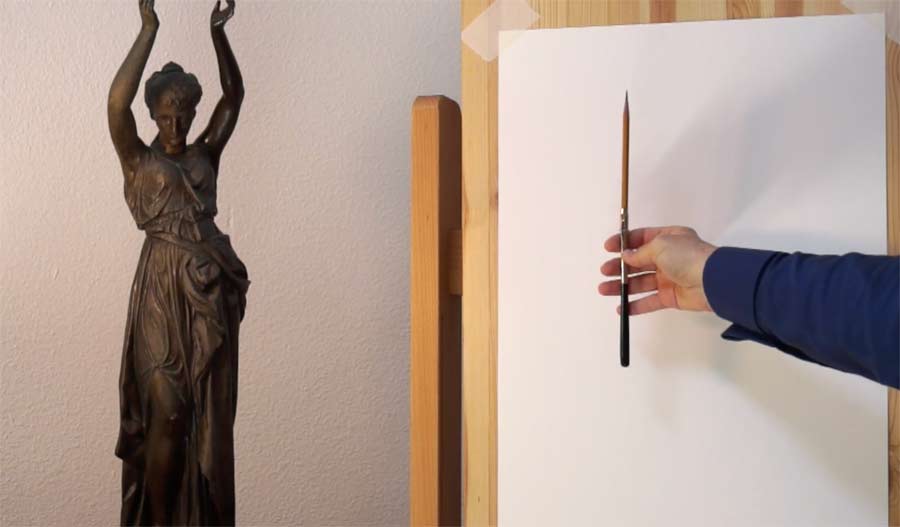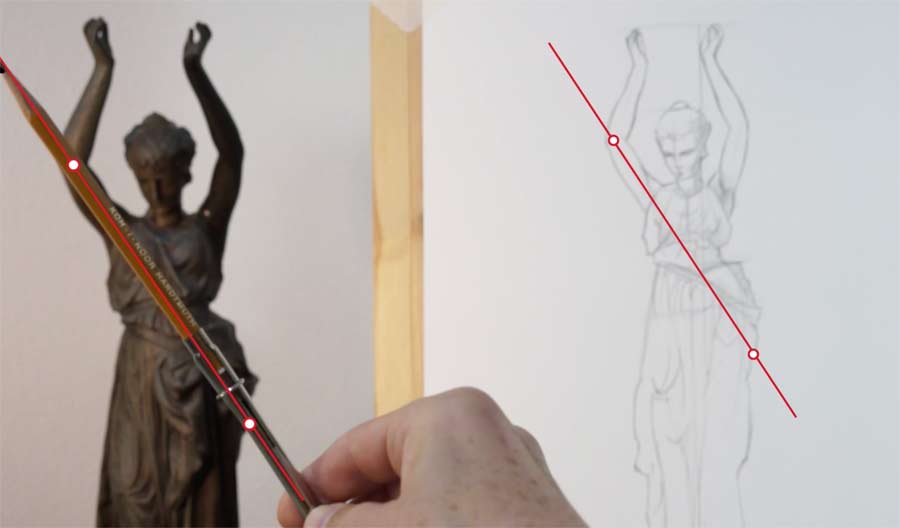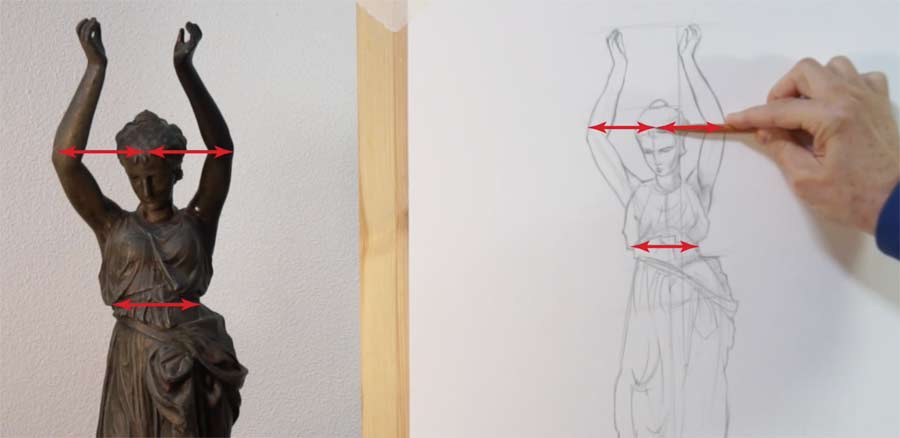How to Measure with a Pencil from Life
Enroll in the Life Drawing Academy now!
How to measure with a pencil
There are five main ways to measure with a pencil from life:
- Measuring vertical alignments
- Measuring horizontal alignments
- Measuring angles
- Measuring cross points, and
- Measuring relative proportions
To measure with a pencil, place a vertically positioned drawing board so you can see both the drawing and the model simultaneously.
For all measurements, fully extend your arm with a pencil, and stand or sit at arm's length from the drawing board. Keep the pencil perpendicular to your line of sight. Close one eye and rotate your whole body towards the model. So, you look through the pencil on the model. Then, keeping your arm straight, rotate your body back to the drawing board, so you can check the same measurement or alignment in drawing.

Let's start with measuring vertical alignments
Keep a pencil strictly vertical at the end of an extended arm. Check some vertical alignment in the drawing. Then rotate the body towards the model and check the same alignment in life. For example, in the drawing, the model's hand is vertically aligned with the side of her neck. We can check if this is the case in life.
Measuring horizontal alignments
By holding a pencil strictly horizontal in a fully outstretched arm, we see that in the drawing, one elbow is slightly higher than the other. By examining the same horizontal alignment in life, we can confirm that the drawing is correct.
Measuring angles
When measuring angles, it is critical to keep a pencil strictly perpendicular to the line of sight. The angle in question—for example, the model's forearm—is then checked both in the drawing and in life.
Measuring Cross Points

We pick one line, for example the angle of the model's arm, and check at what points this line crosses the body. Then, keeping the same angle, we check whether that line has the same cross-points in life.
Measuring relative proportions
This is the most important measuring skill to have.

Hold a pencil in a fully outstretched arm so it's strictly perpendicular to your line of sight. Glide your thumb along the pencil's end and mark the distance in question by aligning it with the model. Then use that dimension to check other relative distances in life. We can see that, for example, the distance between the model's elbows is twice her waist's width. The same relative proportion can then be checked in the drawing, this time by gliding the index finger along the pencil's tip. Such relative proportion measurements work with any dimensions in question. For example, we can compare the model's waist width to her head height.
To learn good drawing techniques, enroll in the Life Drawing Academy course:
Online Course
A self-study, self-paced course for you to learn fundamental methods of classical drawing and improve life drawing skills by watching video lessons and doing assignments
- Unlimited access to 52 life drawing video lessons
- Lifetime membership without deadlines
- Unlimited support from the Academy tutors
- Constructive critique of your artworks
- Member access to the Academy's Art community
- Place in the Academy's Students Gallery
- Exclusive members-only newsletter and bonuses
- Life Drawing Academy Diploma of Excellence in your name
One-time payment - Lifetime membership
$297 USD
Personal Tutoring Online + Online Course
The ultimate choice if you who would like to receive personal, one-to-one tutoring from the Academy teachers, which is custom-tailored to your skills and needs
- Everything in Online Course, plus:
- Dedicated team of art tutors
- Assessment of your current level of drawing skills
- Personalized curriculum tailored to your skills and goals
- Up to 100 drawing tasks with by-task assessment
- Unlimited one-to-one personal coaching with detailed per-task instructions and feedback
- Artwork critiques and results-oriented guidance
One-time payment - Lifetime membership
$997 USD




